You might think you're reading an educational website, where I explain fascinating concepts in space and astronomy, but that's not really what's going on here.
What's actually happening is that you're tagging along as I learn more and more about new and cool things happening in the Universe. I dig into them like a badger hiding a cow carcass, and we all get to enjoy the cache of knowledge I uncover.
Okay, that analogy got a little weird. Anyway, my point is. Squirrel!
Fast radio bursts are the new cosmic whatzits confusing and baffling astronomers, and now we get to take a front seat and watch them move through all stages of process of discovery.
Stage 1: A strange new anomaly is discovered that doesn't fit any current model of the cosmos. For example, strange Boyajian's Star. You know, that star that probably doesn't have an alien megastructure orbiting around it, but astronomers can't rule that out just yet?
Stage 2: Astronomers struggle to find other examples of this thing. They pitch ideas for new missions and scientific instruments. No idea is too crazy, until it's proven to be too crazy. Examples include dark matter, dark energy, and that idea that we're living in a
Stage 3: Astronomers develop a model for the thing, find evidence that matches their predictions, and vast majority of the astronomical community comes to a consensus on what this thing is. Like quasars and gamma ray bursts. YouTuber's make their videos. Textbooks are updated. Balance is restored.
Today we're going to talk about Fast Radio Bursts. They just moved from Stage 1 to Stage 2. Let's dig in.
Fast radio bursts, or FRBs, or "Furbys" were first detected in 2007 by the astronomer Duncan Lorimer from West Virginia University.
He was looking through an archive of pulsar observations. Pulsars, of course, are newly formed neutron stars, the remnants left over from supernova explosions. They spin rapidly, blasting out twin beams of radiation. Some can spin hundreds of times a second, so precisely you could set your watch to them.
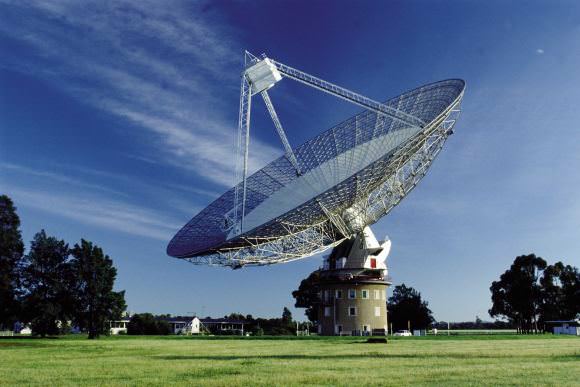
Lorimer's archive of pulsar observations was captured at the Parkes radio dish in Australia. Credit: CSIRO (CC BY 3.0)
In this data, Lorimer made a "that's funny" observation, when he noticed one blast of radio waves that squealed for 5 milliseconds and then it was gone. It didn't match any other observation or prediction of what should be out there, so astronomers set out to find more of them.
Over the last 10 years, astronomers have found about 25 more examples of Fast Radio Bursts. Each one only lasts a few milliseconds, and then fades away forever. A one time event that can appear anywhere in the sky and only last for a couple milliseconds and never repeats is not an astronomer's favorite target of study.
Actually, one FRB has been found to repeat, maybe.
The question, of course, is "what are they?". And the answer, right now is, "astronomers have no idea."
In fact, until very recently, astronomers weren't ever certain they were coming from space at all. We're surrounded by radio signals all the time, so a terrestrial source of fast radio bursts seems totally logical.
About a week ago, astronomers from Australia announced that FRBs are definitely coming from outside the Earth. They used the Molonglo Observatory Synthesis Telescope (or MOST) in Canberra to gather data on a large patch of sky.
Then they sifted through 1,000 terabytes of data and found just 3 fast radio bursts. Three.
Since MOST is farsighted and can't perceive any radio signals closer than 10,000 km away, the signals had to be coming outside planet Earth. They were "extraterrestrial" in origin.
Right now, fast radio bursts are infuriating to astronomers. They don't seem to match up with any other events we can see. They're not the afterglow of a supernova, or tied in some way to gamma ray bursts.
In order to really figure out what's going on, astronomers need new tools, and there's a perfect instrument coming. Astronomers are building a new telescope called the Canadian Hydrogen Intensity Mapping Experiment (or CHIME), which is under construction near the town of Penticton in my own British Columbia.
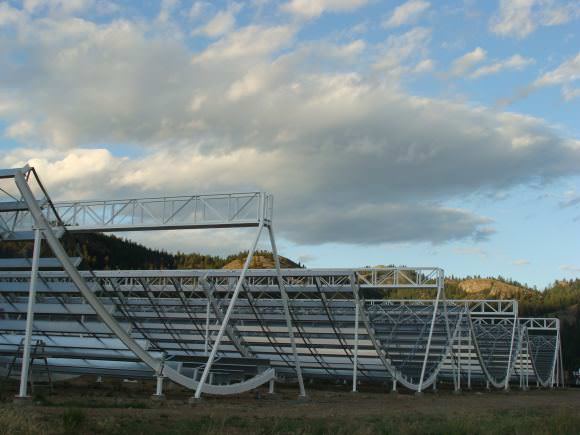
CHIME under construction in Penticton, British Columbia. Credit: Mateus A. Fandiño (CC BY-SA 4.0)
It looks like a bunch of snowboard halfpipes, and its job will be to search for hydrogen emission from distant galaxies. It'll help us understand how the Universe was expanding between 7 and 11 billion years ago, and create a 3-dimensional map of the early cosmos.
In addition to this, it's going to be able to detect hundreds of fast radio bursts, maybe even a dozen a day, finally giving astronomers vast pools of signals to study.
What are they? Astronomers have no idea. Seriously, if you've got a good suggestion, they'd be glad to hear it.
In these kinds of situations, astronomers generally assume they're caused by exploding stars in some way. Young stars or old stars, or maybe stars colliding. But so far, none of the theoretical models match the observations.
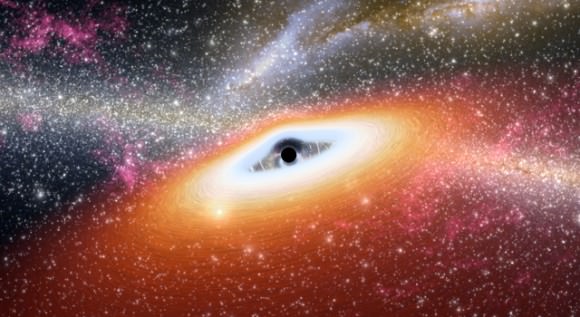
This artist's conception illustrates one of the most primitive supermassive black holes known (central black dot) at the core of a young, star-rich galaxy. Image credit: NASA/JPL-Caltech
Another idea is black holes, of course. Specifically, supermassive black holes at the hearts of distant galaxies. From time to time, a random star, planet, or blob of gas falls into the black hole. This matter piles upon the black hole's event horizon, heats up, screams for a moment, and disappears without a trace. Not a full on quasar that shines for thousands of years, but a quick snack.
The next idea comes with the only repeating fast radio burst that's ever been found. Astronomers looked through the data archive of the Arecibo Observatory in Puerto Rico and found a signal that had repeated at least 10 times in a year, sometimes less than a minute apart.
Since the quick blast of radiation is repeating, this rules out a one-time collision between exotic objects like neutron stars. Instead, there could be a new class of magnetars (which are already a new class of neutron stars), that can release these occasional shrieks of radio.
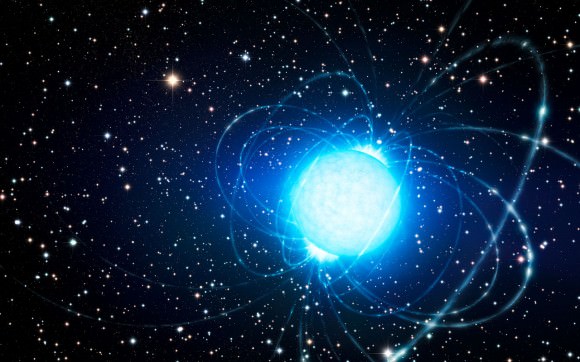
An artist's impression of a magnetar. Credit: ESO/L. Calçada
Or maybe this repeating object is totally different from the single events that have been discovered so far.
Here's my favorite idea. And honestly, the one that's the least realistic. What I'm about to say is almost certainly not what's going on. And yet, it can't be ruled out, and that's good enough for my fertile imagination.
Avi Loeb and Manasvi Lingam at Harvard University said the following about FRBs:
"Fast radio bursts are exceedingly bright given their short duration and origin at distances, and we haven't identified a possible natural source with any confidence. An artificial origin is worth contemplating and checking."
Artificial origin. So. Aliens. Nice.
Loeb and Lingam calculated how difficult it would be to send a signal that strong, that far across the Universe. They found that you'd need to build a solar array with twice the surface area of Earth to power the radio wave transmitter.
And what would you do with a transmission of radio or microwaves that strong? You'd use it to power a spacecraft, of course. What we're seeing here on Earth is just the momentary flash as a propulsion beam sweeps past the Solar System like a lighthouse.
But in reality, this huge solar array would be firing out a constant beam of radiation that would propel a massive starship to tremendous speeds. Like the Breakthrough Starshot spacecraft, but for million tonne spaceships.
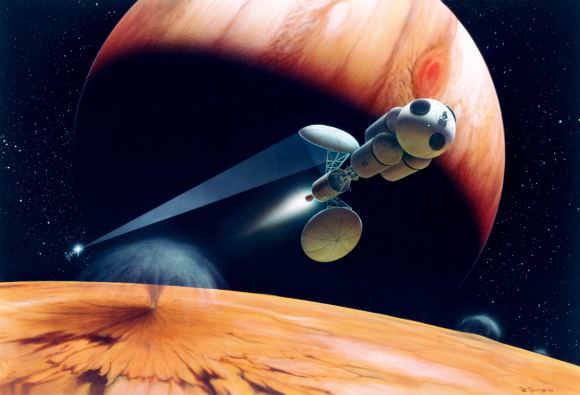
Credit: NASA/Pat Rawlings (SAIC)
In other words, we could be witnessing alien transportation systems, pushing spacecraft with beams of energy to other worlds.
And I know that's probably not what's happening. It's not aliens. It's never aliens. But in my mind, that's what I'm imagining.
So, kick back and enjoy the ride. Join us as we watch astronomers struggle to understand what fast radio bursts are. As they invalidate theories, and slowly unlock one of the most thrilling mysteries in modern astronomy. And as soon as they figure it out, I'll let you know all about it.
What do you think? Which explanation for fast radio bursts seems the most logical to you? I'd love to hear your thoughts and wild speculation in the comments.
No comments:
Post a Comment